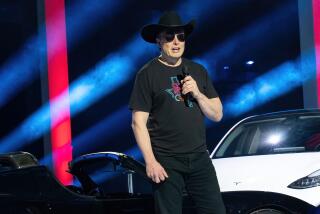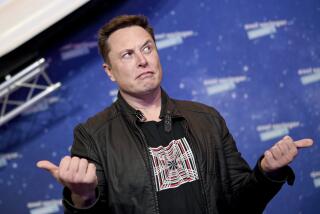Is he a Tesla stalker or just a very meticulous researcher? A judge will decide
Is Randeep Hothi a stalker, a harasser, a perpetrator of violence and an imminent threat? Or is he a mild-mannered academic engaged in legal if unorthodox research for his investments?
Is Tesla’s Elon Musk an intimidator who uses his wealth, power and Twitter account to silence critics? Or is he simply trying to protect his employees from possible harm?
Those questions are being asked in Alameda County Superior Court, where Tesla seeks a permanent restraining order against Hothi.
Tesla says Hothi struck a Tesla security employee with his car at the company’s Fremont, Calif., assembly plant, and that he later endangered workers in a Tesla Model 3 who were testing driverless technology at highway speeds on Interstate 880 between Fremont and the Oakland side of the Bay Bridge.
Hothi, a doctoral student at the University of Michigan and Tesla critic who lives near the Fremont plant, says Tesla is lying to smear him and shut him up.
The case took a turn in Hothi’s favor last week, when Judge Jeffrey Brand backed a request by his lawyers that Tesla release video recordings that they say are relevant to the case. Brand ordered Tesla to turn the videos over — along with any relevant photographs and audio recordings — by July 16.
Tesla asked the judge to bar the media from future hearings. The judge declined to do so.
Hothi is part of a Twitter group of short sellers and other Tesla critics known as $TslaQ. Participants monitor Tesla for flaws in its business model and evidence that the company’s stock price is far higher than it should be, based on business fundamentals. Many of them, including Hothi, have bet on the stock price falling — which it has been doing, for the most part, recently. It closed at $230.34 on Monday, down 1.2% on the day and 27% year to date.
Another member of the group, Lawrence Fossi, an investment manager who goes by the Twitter handle Montana Skeptic, set up a GoFundMe page for Hothi’s legal expenses. So far, it has raised $118,000.
According to Hothi’s court response to Tesla’s accusations, “Tesla has a history of using the legal system to silence its critics.” The document pointed to the widely publicized story of Martin Tripp, a former employee who became a whistleblower, saying Tesla knowingly manufactured and sold defective batteries. “Tesla CEO Musk set out to destroy him,” the court response said. Tesla sued Tripp for $167 million. An anonymous caller had contacted the company to say that Tripp was planning a mass shooting, a report that was relayed to police. According to Bloomberg Businessweek, “Tesla’s PR department spread rumors that Tripp was possibly homicidal and had been part of a grand conspiracy” and the company fired another whistleblower, former Tesla security manager Sean Gouthro.
Tesla said at the time that the allegations concerning Tripp were “untrue and sensationalized.” The case is pending in the U.S. District Court in Nevada.
After Fossi’s identity was revealed last year, Musk called Fossi’s boss and threatened a lawsuit. And Hothi’s court filing brought up the case of Tesla regional manager Adam Williams, who reported to superiors that employees were knowingly selling defective cars; the document said Williams was demoted and later fired. He sued Tesla last year. Tesla said at the time that Williams was fired only for poor performance and that his suit had “no merit” and “it’s also at odds with the fact that we rank highest in customer satisfaction of any car brand.”
Musk, openly contemptuous of short sellers on Twitter, may be especially sensitive to criticism of the company’s autonomous driving technology, a key strategic program whose successes and failures are bound to affect the company’s stock price.
Hothi had kept an eye on production at Tesla’s assembly plant, counting cars to match against Tesla’s production claims. He often took photographs from just outside the plant, and sometimes positioned a camera (on public property, he said) to remotely record activity. He posted his observations under the Twitter handle Skabooshka.
On Feb. 21, Hothi sat in his car in a publicly accessible area of the Fremont plant’s parking lot near a Tesla sales showroom. When confronted by a security guard, Tesla said in court documents, Hothi “fled the scene” and “hit Tesla’s security employee Tyler James with his car” resulting in “minor injuries.”
Fremont police reviewed the case and concluded it did not meet the elements of a hit and run, according to court records filed by Hothi’s attorney. Police forwarded the case to the county district attorney’s office, which declined to prosecute, stating there was insufficient evidence that Hothi hit James with his car, according to court records. Hothi never returned to the Fremont plant after that day, his lawyer said.
On April 16, according to Tesla, three employees sat in a Model 3 mounted with camera equipment while testing the car’s autonomous driving capabilities. The company said in court filings that Hothi “pursued” the employees for 35 minutes, “driving ahead of, beside, and behind them, and swerving dangerously close to the vehicle,” perhaps to spark a response from the car’s autonomous system. The employees feared that Hothi’s “road conduct would cause a collision and injure them.” Hothi said those statements are false.
In a court response, Hothi’s lawyer said, “Randeep was critically researching Tesla’s extravagant claims” about the capabilities of its “full self driving” systems.
“I did not swerve at any vehicle whatsoever,” Hothi said in an interview. He assumed the video footage being shot that day would be used as marketing material, said D. Gill Sperlein, Hothi’s lawyer. Hothi intended to record the car’s journey to compare it with any edited version that Tesla might show in the future.
After that incident, Tesla sought and was granted a temporary restraining order against Hothi.
Sperlein cited the camera system mounted on the test car, and the eight cameras typically installed on all Teslas to enable autonomous driving, in his request that the company provide footage to use as evidence.
The case is being tried in a court loaded with workplace harassment and other cases involving restraining order requests. On the same day the Hothi hearings began, Judge Brand heard a case involving an argument between a bus driver and a retired bus driver that ended in fisticuffs, and another involving a long-running dispute between two elderly neighbors in which one allegedly brandished his walking stick as a weapon and the other pulled out a knife and vowed to “cut you open like a fish.” To speed such cases along, legal discovery — the process of gathering evidence from the other side — usually is not allowed.
In Tesla’s case, though, the judge made an exception, writing that despite the company’s objections based on confidentiality and privacy, among other things, “Production of any such recordings would impose a minimal burden on the parties.”
He added, “If any party were in possession of such recordings and decided not to present them at trial, then the court might be inclined to draw an adverse influence.”
Hothi told The Times he believes no video exists that shows him driving in the manner Tesla is claiming.
Tesla did not respond to requests for comment.
The next court hearing is set for July 26.
Twitter: @russ1mitchell







